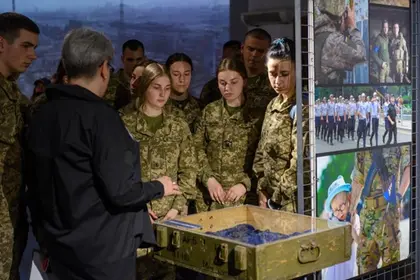The M86 exhibition, which opened at the Museum and Exhibition Center of History of Kyiv this week, was created by Big City Lab and the National Museum of Ukrainian History (MIST), with the support of Mariupol Reborn.
It presents a unique day-by-day record of the heroic defense of Mariupol in honor of those who fought and died from the beginning of Russia’s full-scale invasion on Feb. 24 2022 to May 20 2022, when the city’s defenders were finally ordered to leave the Azovstal steelworks.
JOIN US ON TELEGRAM
Follow our coverage of the war on the @Kyivpost_official.
Victoria Titova, СЕО of Big City Lab, said “This Chronicle is only the beginning of the process of preserving these important memories. As an urban bureau, we have been supporting Mariupol for many years and it is very clear that memory is an integral part of the city. This is an open code, with input from thousands of sources.
“We gathered hundreds of soldiers’ testimonies, examined thousands of photos, videos and satellite images, and tens of thousands of files. And we have verified the information with the commanders. Finally, we are ready to present the daily chronicle of Mariupol’s defense.”
Natalia Yemchenko, Member of the Supervisory Board of the NGO Mariupol Reborn and SCM Communication Director, said, “More than 2,000 defenders remain in Russian captivity. It’s time for us to fight for those who sacrificed so much for us. M86 details the events of two years ago. But it is also a powerful tool for Ukraine’s struggle for the return of captives.”

One Killed in Odesa, Four in Kharkiv as Russia Launches Another Night of Strikes on Ukraine
Rostislav Karandeyev, the Acting Minister of Culture and Information Policy of Ukraine, attended the launch: “A great state task is to preserve memory, to design and systematize it, to bring it to future generations in the form that will help us to fulfill and realize all tasks for the education of real Ukrainians.
“Education is not about tragedy or losses. Instead, it is about heroism and achievement. And this was Mariupol’s feat, the feat of Azovstal and all those who defended the city from the enemy for 86 days. Thank you to everyone involved in the organization of this project. This is undoubtedly a great state project.”
The most important people in the M86 story are the soldiers themselves who, according to the General Staff, tied down around 17 Russian battalions, around 20,000 troops, for the best part of three months, preventing them from being transferred to other fronts. This prevented the Russian plan to rapidly capture Zaporizhzhia and to gain entry to the administrative border of the Donetsk and Zaporizhzhia regions.
Much of the exhibition recounts in their own words the experiences of commanders and ordinary fighters, who relive the hopes and fears they shared as the fighting continued and when it finally ended.
Anton Drobovych, Director of the Ukrainian Institute of National Memory, said, “This chronicle of Mariupol’s defense is one of the most interesting studies of the first phase of a full-scale Russian invasion. It combines the timeline of events with the testimony of many eyewitnesses, filling the historical presentation of expressiveness and imagery.”
An important element of the presentation was the international exhibition of posters from Big City Lab, the National Museum of History of Ukraine and 4th Block.
The exhibition runs from Feb. 22 to March 7 at the Museum of History of Kyiv after which it will be presented in the main program of the 12th International Triennial “4th Block” in Kharkiv – Ukraine; Graz – Austria; New York and Los Angeles – US.
You can also highlight the text and press Ctrl + Enter






